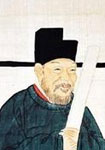“桃红李花白”的意思及全诗出处和翻译赏析
“桃红李花白”全诗
风吹百草根,道路千里碧。
莫尽溪漫漫,波澜散无迹。
遥林缺见山,冉冉苍蔼积。
沙禽有遗踪,文字不可识。
青松对桃李,桃红李花白。
红白势方竞,青青守岩侧。
君意无不谐,研谈欲俱得。
赋诗多所陈,炳若观龟坼。
城东不待到,众物已历历。
分类:
作者简介(曾巩)

曾巩(1019年9月30日-1083年4月30日,天禧三年八月二十五日-元丰六年四月十一日),字子固,世称“南丰先生”。汉族,建昌南丰(今属江西)人,后居临川(今江西抚州市西)。曾致尧之孙,曾易占之子。嘉祐二年(1057)进士。北宋政治家、散文家,“唐宋八大家”之一,为“南丰七曾”(曾巩、曾肇、曾布、曾纡、曾纮、曾协、曾敦)之一。在学术思想和文学事业上贡献卓越。
《和章友直城东春日》曾巩 翻译、赏析和诗意
《和章友直城东春日》是宋代文学家曾巩创作的一首诗词。以下是对该诗词的中文译文、诗意和赏析:
中文译文:
东流抱孤城,
雨洗见春色。
风吹百草根,
道路千里碧。
莫尽溪漫漫,
波澜散无迹。
遥林缺见山,
冉冉苍蔼积。
沙禽有遗踪,
文字不可识。
青松对桃李,
桃红李花白。
红白势方竞,
青青守岩侧。
君意无不谐,
研谈欲俱得。
赋诗多所陈,
炳若观龟坼。
城东不待到,
众物已历历。
诗意:
这首诗描绘了一个城东春日的景象。东边的河流环绕着这座孤零零的城池,雨水洗净了大地,春色显现。微风吹动着百草的根,道路延伸千里呈现一片碧绿。溪水漫过无边无际,波澜散去无痕迹。远处的林木中,山峰隐约可见,苍翠积聚。河滩上留下了沙禽的足迹,但无法辨认文字。青松与桃李相对立,桃花红艳,李花洁白。红色和白色的竞争势头,而青松守护在岩石旁边。君子的意愿没有不协调的地方,研究和谈论欲望都能得到满足。赋诗描绘了许多事物,如同观看龟裂的龟壳一样炫耀。虽然城东的景色还未到达,但周围的一切已经历历在目。
赏析:
这首诗词以简洁而生动的语言描绘了一个春日的景色,通过自然景物的描写表达了作者对大自然的观察和感受。诗中运用了丰富的自然意象,如东流、雨洗、风吹、百草、溪水、青松、桃李等,使读者仿佛身临其境,感受到了春日的美好气息。诗中还运用了对比的手法,如红白的竞争和青松守岩侧,展现了自然界中的变化与平衡。整首诗词表达了作者对自然景物的赞美,以及对生活态度的思考,强调了君子的意愿和人与自然的和谐相处。
曾巩是宋代文学史上的重要作家,他的作品以纯熟的艺术技巧和深邃的思想内涵著称。这首诗词展示了他对自然景物的细腻观察和对人生哲理的思考,同时也体现了他对诗词艺术的造诣。通过欣赏这首诗词,读者可以感受到曾巩的文学才华和对自然美的独特感悟,同时也能引发对人与自然关系以及生活的思考。注:这个中文诗词的中文译文已经提供了,以下是对该诗词的英文翻译、诗意和赏析:
English Translation:
Embracing the solitary city by the eastern stream,
Rain-washed, revealing the colors of spring.
The wind blows, grasses deeply rooted,
The roads extend for miles, a thousand-league expanse of green.
Endless streams flow slowly,
Waves dispersing without a trace.
Distant forests reveal glimpses of mountains,
Lush and dense, rising gradually.
Sandbirds leave their traces,
Unrecognizable in written words.
Green pines stand opposite the peach and plum,
Peach blossoms red, plum blooms white.
Red and white vie for dominance,
Green remains steadfast by the cliffs.
Your intentions are always harmonious,
Discussions and studies yield mutual gains.
Your poetic compositions are plentiful,
Brilliant, like the patterns on a tortoise shell.
Before reaching the east of the city,
All things have been clearly experienced.
Poetic Meaning:
This poem depicts the scene of a spring day in the eastern part of a city. The city is embraced by a flowing river, and after the rain, the colors of spring become visible. The wind blows, causing the grass to sway deeply rooted, while the roads stretch for miles, appearing as a green expanse. The meandering streams seem endless, with waves dispersing without leaving a trace. In the distance, the forests reveal glimpses of mountains that gradually accumulate in a lush and dense manner. Sandbirds leave their tracks on the sandy riverbanks, but their footprints cannot be deciphered in writing. Green pines stand opposite peach and plum trees, with peach blossoms in red and plum blossoms in white. The red and white colors compete for dominance, while the green pine remains steadfast by the cliffs. Your intentions are always harmonious, and discussions and studies bring about mutual gains. Your poetic compositions cover a wide range of subjects, shining brightly like the patterns on a tortoise shell. Although the eastern part of the city has not been reached, everything around has been experienced vividly.
Appreciation:
This poem vividly describes the scenery of a spring day using concise and lively language. Through the depiction of natural scenery, the poet expresses his observations and feelings towards nature. The poem employs rich natural imagery, such as flowing streams, rain-washed scenes, blowing wind, grasses, and pine trees, creating an immersive experience for the readers, allowing them to sense the beauty of spring. The poem also utilizes contrasting techniques, such as the competition between red and white and the steadfastness of the green pine, showcasing the changes and balance in the natural world. The entire poem expresses the poet's admiration for natural scenery and contemplation of life's attitudes, emphasizing the harmony between noble intentions and the coexistence of humans and nature.
Zeng Gong, an important writer in the history of Song Dynasty literature, is renowned for his skilled artistic techniques and profound philosophical thoughts in his works. This poem demonstrates his delicate observations of natural scenery and contemplation of philosophical ideas, showcasing his mastery in the art of poetry. By appreciating this poem, readers can perceive Zeng Gong's literary talent, unique insights into the beauty of nature, and be inspired to contemplate the relationship between humans and nature and the meaning of life.
“桃红李花白”全诗拼音读音对照参考
hé zhāng yǒu zhí chéng dōng chūn rì
和章友直城东春日
dōng liú bào gū chéng, yǔ xǐ jiàn chūn sè.
东流抱孤城,雨洗见春色。
fēng chuī bǎi cǎo gēn, dào lù qiān lǐ bì.
风吹百草根,道路千里碧。
mò jǐn xī màn màn, bō lán sàn wú jī.
莫尽溪漫漫,波澜散无迹。
yáo lín quē jiàn shān, rǎn rǎn cāng ǎi jī.
遥林缺见山,冉冉苍蔼积。
shā qín yǒu yí zōng, wén zì bù kě shí.
沙禽有遗踪,文字不可识。
qīng sōng duì táo lǐ, táo hóng lǐ huā bái.
青松对桃李,桃红李花白。
hóng bái shì fāng jìng, qīng qīng shǒu yán cè.
红白势方竞,青青守岩侧。
jūn yì wú bù xié, yán tán yù jù dé.
君意无不谐,研谈欲俱得。
fù shī duō suǒ chén, bǐng ruò guān guī chè.
赋诗多所陈,炳若观龟坼。
chéng dōng bù dài dào, zhòng wù yǐ lì lì.
城东不待到,众物已历历。
“桃红李花白”平仄韵脚
平仄:平平仄平平
韵脚:(仄韵) 入声十一陌 * 平仄拼音来自网络,仅供参考;诗句韵脚有多个的时候,对比全诗即可判断。